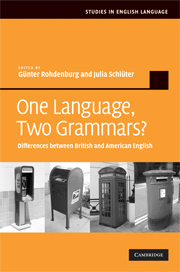Book contents
- Frontmatter
- Contents
- List of figures
- List of tables
- List of contributors
- Introduction
- 1 Colonial lag, colonial innovation or simply language change?
- 2 Compound verbs
- 3 The formation of the preterite and the past participle
- 4 Synthetic and analytic comparatives
- 5 Phonology and grammar
- 6 Prepositions and postpositions
- 7 Argument structure
- 8 Reflexive structures
- 9 Noun phrase modification
- 10 Nominal complements
- 11 Non-finite complements
- 12 The present perfect and the preterite
- 13 The revived subjunctive
- 14 The mandative subjunctive
- 15 The conditional subjunctive
- 16 Tag questions
- 17 The pragmatics of adverbs
- 18 How different are American and British English grammar? And how are they different?
- 19 New departures
- Bibliography
- Index
12 - The present perfect and the preterite
Published online by Cambridge University Press: 03 July 2009
- Frontmatter
- Contents
- List of figures
- List of tables
- List of contributors
- Introduction
- 1 Colonial lag, colonial innovation or simply language change?
- 2 Compound verbs
- 3 The formation of the preterite and the past participle
- 4 Synthetic and analytic comparatives
- 5 Phonology and grammar
- 6 Prepositions and postpositions
- 7 Argument structure
- 8 Reflexive structures
- 9 Noun phrase modification
- 10 Nominal complements
- 11 Non-finite complements
- 12 The present perfect and the preterite
- 13 The revived subjunctive
- 14 The mandative subjunctive
- 15 The conditional subjunctive
- 16 Tag questions
- 17 The pragmatics of adverbs
- 18 How different are American and British English grammar? And how are they different?
- 19 New departures
- Bibliography
- Index
Summary
Introduction
Like a large number of other languages, English has two competing verbal constructions commonly used to refer to past time: the periphrastic present perfect and the synthetic preterite, as in, respectively,
(1) I have seen him recently
and
(2) I saw him recently.
The distribution of the two constructions varies a great deal between languages, and also within individual languages. For example, German and French can easily have constructions like
(3) Ich habe ihn gestern gesehen
and
(4) Je l'ai vu hier.
However, the corresponding construction would not seem acceptable in English:
(5) I have seen him yesterday.
The problem is that, unlike German and French, English puts very severe restrictions on the combination of the present perfect with specifications of a clearly defined temporal location wholly in the past. Instead, English generally prefers the preterite in such cases.
Moreover, the distinction between the two verb forms is drawn differently in American as compared with British English. While the basic rules are the same, a sentence like our example (1) above would often be preferred by speakers of BrE, while many speakers of AmE would be more likely to opt for (2). The point here is that, although the reference is clearly to past time, this time is not very precisely defined, which leaves considerable scope for individual judgement. In such cases there appears to be a distinct tendency for AmE to select the preterite, BrE the present perfect, so that on the whole the latter verb form is more frequent in BrE than in AmE.
- Type
- Chapter
- Information
- One Language, Two Grammars?Differences between British and American English, pp. 228 - 245Publisher: Cambridge University PressPrint publication year: 2009
- 18
- Cited by



